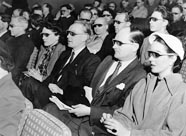
3D Vision: Is Yours Waxing or Waning?
On this day in 1953, the horror film The House of Wax, starring Vincent Price, opened in New York. It was the first movie from a major motion-picture studio to be shot using the three-dimensional, or stereoscopic, film process and one of the first horror films to be shot in color.
The 3-D filming process involved using two cameras, or a single twin-lensed camera, to represent both the right and the left eye of the human viewer. Images from the two cameras were then projected simultaneously onto the screen. Moviegoers had to view The House of Wax through special stereoscopic glasses to see its full 3-D effect. The lenses were specially tinted so that the viewer would see the right- and left-eye images only with the eyes for which they were intended. The 3-D process proved especially effective during the film’s climactic chase scene, in which the cloaked killer pursues Kirk’s character through a series of gas-lit streets and alleyways, with the viewer following along behind them.
House of Wax earned an impressive (by 1953 standards) $4.3 million at the box office and sparked an explosion of similar 3-D thrillers. However, at that time the popularity of 3-D movies lasted only about a year in the US. With the invention of IMAX in 2002, 3-D movies, and the glasses through which to watch them, have greatly improved. Still, not everyone has a pleasant 3-D experience and it has nothing to do with the plot of the movie.
According to the American Optometry Association (AOA) there are 3 to 9 million people with binocular vision problems. Binocular vision (Stereoscopy) is the ability to align and focus both eyes accurately on an object and then combine the visual images from each eye into a single, clear three dimensional perception. Difficulty seeing in 3D can arise when eye fatigue occurs, forcing the eyes to make adjustments to focus simultaneously on images that are near and far away.
Symptoms indicating a potential problem viewing images in 3D can vary, but some common symptoms include headaches, blurred vision, nausea and dizziness.
The AOA recommends seeing a doctor of optometry for further evaluation if consumers answer yes to any of the following questions:
• Do you experience eyestrain or headaches during or after viewing?
• Do you feel nauseated or dizzy during or after viewing?
• Are you more comfortable viewing 2D TV or movies instead of 3D TV/movies?
• Is it difficult for your eyes to adjust back to normal after watching 3D TV/movies?
• Do other people seem to be enjoying the 3D viewing experience more than you?
****
The M&S Smart System® 20/20 gives you the ability to determine threshold distance stereo testing with either red\blue anaglyphs or liquid crystal shutter glasses. Both applications can use either contour stereo or random dot stereo for quick, efficient analysis.
Please contact us for more information about this industry-exclusive feature.
Have other questions about 3D vision problems? Click here for the FAQ page from the AOA.
Have a thought about this article? Contact Us and let us know.